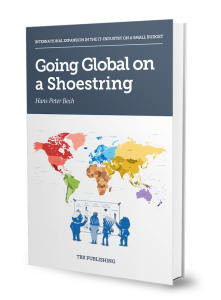
“How long is a shoestring?” asked Rick Pizzoli when he first heard about the title of my next book. Rick, who runs Sales Force Europe and lives by helping, primarily US, companies enter the European markets, knows about where the challenges lie. He is therefore also one of the book’s many sources.
How do you get into the international markets without having to invest more than your business can bear? That is the question I answer in my book titled Going Global on a Shoestring. The subtitle is International Expansion in the IT Industry on a Small Budget.
The research work, that was just recently completed, included interviews of 23 companies, but the book contains many more examples from real life, including from my own work as a consultant and international business developer.

The idea for the book came in the wake of a series of workshops I held at Sabanci University’s School of Management in Istanbul a few years ago. In the classes sat well over a hundred managers of smaller software companies, all of whom had exciting products, were fuelled by the ambition to enter international markets, but did not know how to approach it. I have held similar workshops in other countries and also at home. The challenges are exactly the same. The products have international potential, but where do you begin and how can you get started without having to bet the entire farm? A book of experiences and ideas could help more people to make a realistic plan and try it out.
The many shipwrecks
The challenge is that as a small business you can easily endanger the entire life of the shop by investing outside your domestic market. The book therefore initially describes a number of such examples of notorious disasters from the internationalization wonderland. The examples do not intend to scare anyone away, but should urge caution and above all for ingenuity. It can easily go terribly wrong, and it can not so easily go well. History shows that the traps often do not lie in unexpected places and represent combinations of conditions that you could have foreseen if you had had the relevant experience represented in the preparation phase and in the project follow-up group.

But the shipwrecks also illustrate that the companies are in completely different markets and situations. Although the book deals exclusively with IT companies (primarily software), products and markets differ widely. Are there any common denominators, rules of thumb or even recipes that apply to everyone? Yes, there are. Maybe not exactly a recipe, but I do believe there are principles and methods that can be used by everyone, and I describe them in the book.
When tasks are approached differently, it is often solely because the people behind the companies are different. We do things differently simply because we are different. This is also the case with internationalization. Business leaders’ way of tackling the challenges is not always because their situations are so different, but that they are human beings. Some are convinced that hiring local leaders abroad is the best approach. Others believe that you should start by relocating some of your already trusted employees first. There are examples that both work and do not work, so no definitive conclusion can be made, but each model has its advantages and disadvantages that must be weighed in a specific situation. It is my goal that the book should help decision-makers make better choices based on sober trade-offs rather than their prejudices.
Things take time

The book has been brewing for a long time. However, there have been other activities that have taken my time, and it is actually a difficult book to write. Although I work exclusively with IT companies, focus on smaller companies and only deal with the first steps to ensure a solid bridgehead, the subject area is very large.
I have decided to skip all the traditional stuff with formal corporate setups, trade restrictions, national legislation and cultural differences. Partly because much has been written about it elsewhere, and partly because it doesn’t really make a big difference. The knowledge you need to have in these areas can be acquired when it becomes relevant. The more soft parts such as choosing a market, organizing your resources, choosing forms of collaboration and partners and determining the initial initiatives are far more crucial to whether or not you succeed.
You can read one of the case stories here.
If you would like to be notified when the book is released, click here.
